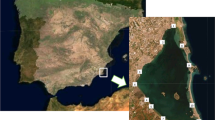Abstract
The residues of organochlorine pesticides (HCHs and DDTs) in a dated (137Cs and 210Pb) sediment core from the Küçükçekmece Lagoon, an urban lake at the southern entrance of the future Canal Istanbul Project, an artificial watercourse, were analyzed with the gas chromatograph equipped with electron capture detector (GC 63Ni-ECD). Concentrations of ∑HCH and ∑DDT along the core varied between 0.4 and 469.4 (average 51.4) ng g−1 dw, and between 0.5 and 72.0 (average 7.4) ng g−1 dw, respectively. α-HCH was the predominant isomer (98%) and followed by γ-isomer (2%). The highest concentrations of technical HCH were found in the sediments dated 1963–1972, whilst the DDT concentrations had their maximum around 1945. The highest concentrations of γ-HCH and p,p′-DDT exceeded probable-effect level values which can lead to frequently cause adverse effects on aquatic biota.


Similar content being viewed by others
References
Ağar S, Aydınoğlu H, Temel O, İkizünal K, Ece H (1991) Pestisit kullanımının tarihçesi, bugünü ve geleceği (History of pesticide use, today and future), Turk Entomol Derg-Tu. (Turkish Journal of Entomology) 15(4):247–256 (in Turkish)
Appleby PG, Oldfield F (1978) The calculation of lead-210 dates assuming a constant rate of supply of unsupported 210Pb to the sediment. Catena 5:1–8
Barakat AO, Mostafa A, Wade TL, Sweet ST, El Sayed NB (2012) Spatial distribution and temporal trends of persistent organochlorine pollutants in sediments from Lake Maryut, Alexandria, Egyptian. Mar Pollut Bull 64:395–404
Barber JL, Sweetman AJ, van Wijk D, Jones KC (2005) Hexachlorobenzene in the global environment: emissions, levels, distribution, trends and processes. Sci Total Environ 349:1–44
Blus LJ (1995) Organochlorine pesticides. In: Hoffman DJ, Rattner BA, Burton GA Jr, Cairns J Jr (eds) Handbook of ecotoxicology. Lewis Publishers, Boca Raton, p 275
Bojakowska I, Stasiuk M, Gąsior J, Wołkowicz W (2014) Assessment of DDT, HCH and PCB pollution of lake sediments in Poland. Limnol Rev 14(2):63–74
CCME (2002) Canadian sediment quality guidelines for the protection of aquatic life: summary tables. Canadian Environmental Quality Guidelines, Winnipeg
Chattopadhyay S, Chattopadhyay D (2015) Remediation of DDT and its metabolites in contaminated sediment. Curr Pollut Rep 1:248–264
Cheng H, Lin T, Zhang G, Liu G, Zhang W, Qi S, Jones KC, Zhang X (2014) DDTs and HCHs in sediment cores from the Tibetan Plateau. Chemosphere 94:183–189
Demirci A, McAdams MA, Alagha O, Karakuyu M (2006) The relationship between land use change and water quality in Küçükçekmece lake watershed, 4th GIS days in Turkey, Sept 13–16, 2006, Fatih University, Istanbul, Turkey
Doong RA, Peng CK, Sun YC, Liao PL (2002) Composition and distribution of organochlorine pesticide residues in surface sediments from the Wu-Shi River estuary, Taiwan. Mar Pollut Bull 45:246–253
FAO (2000) FAO FAO Pesticide disposal series 8, assessing soil contamination, a reference manual, FAO information division. Food and Agriculture Organization of the United Nations, Rome
Guo JY, Wu FC, Liao HQ, Zhao XL, Li W, Wang J, Wang LF, Giesy JP (2013) Sedimentary record of polycyclic aromatic hydrocarbons and DDTs in Dianchi Lake, an urban lake in Southwest China. Environ Sci Pollut Res 20:5471–5480
Hitch RK, Day HR (1992) Unusual persistence of DDT in some western USA soils. Bull Environ Contam Toxicol 48:259–264
Hui H, Zang S (2014) Distribution and ecological risk assessment of organochlorine pesticides in sediments from four lakes of Heilongjiang Province, China. Ecotoxicology 23(4):601–608
Iwata H, Tanabe S, Ueda K, Tatsukawa R (1995) Persistent organochlorine residues in air, water, sediments, and soils from the lake Baikal region, Russia. Environ Sci Technol 29:792–801
Liu G, Zhang G, Jin Z, Li J (2009) Sedimentary record of hydrophobic organic compounds in relation to regional economic development: A study of Taihu Lake, East China. Environ Pollut 157:2994–3000
MacDonald DD, Ingersoll CG, Berger TA (2000) Development and evaluation of consensus-based sediment quality guidelines for freshwater ecosystems. Achieve Environ Contam Toxicol 39:20–31
MacKay D, Shiu WY, Ma KC (1992) Illustrated handbook of physical-chemical properties and environmental fate for organic chemicals, vol 1. Monoaromatic hydrocarbons, Chlorobenzenes and PCBs. Lewis Publisher, Boca Raton
Metcalf RL (1955) Organic insecticides, their chemistry and mode of action. Wiley-Interscience, New York, pp 213–227
Nizzetto L, Macleod M, Borga K, Cabraerizo A, Dachs J, Di Guardo A, Ghirardello D, Hansen KM, Jarvis A, Lindroth A, Ludwig B, Monteith D, Prlinger JA, Schringer M, Schwendenmann L, Semple KT, Wick LY, Zhang G, Jones KC (2010) Past, present, and future controls on levels of persistent organic pollutants in the global environment. Environ Sci Technol 44(17):6526–6531
Peng X, Zhang G, Zheng L, Mai B, Zeng S (2005) The vertical variations of hydrocarbon pollutants and organochlorine pesticide residues in a sediment core in Lake Taihu, East China. Geochem Explor Environ Anal 5:99–104
Şenduran C (2007) Investigation of limnology and sediment transport properties of Küçükçekmece lagoon. MSc Thesis, Yildiz Technical University, Istanbul
Taner M, Üstün B, Erdinçler A (2011) A simple tool for the assessment of water quality in polluted lagoon systems: a case study for Küçükçekmece Lagoon, Turkey. Ecol Indic 11:749–756
Thomas JE, Ou LT, Al-Agely A (2008) DDE remediation and degradation. In: Whitacre DM (ed) Reviews of Environmental Contamination and Toxicology, 194. Springer, New York
Tuğluoğlu F (2008) Türkiye’de Sıtma Mücadelesi (1924–1950). Türkiye Parazitoloji Dergisi 32(4):351–359 (in Turkish)
Yuan L, Qi S, Wu X, Wu C, Xing X, Gong X (2013) Spatial and temporal variations of organochlorine pesticides (OCPs) in water and sediments from Honghu Lake, China. J Geochem Explor 132:181–187
Zhou RB, Zhu LH, Yang K, Chen YY (2006) Distribution of organochlorine pesticides in surface water and sediments from Qiantang River, East China. J Hazard Mater 137(1):68–75
Acknowledgements
We are grateful to Dr. Y. Altinok for sediment coring. This study was made possible by the financial supports from TÜBITAK (112Y104) and the Research Fund of Istanbul University (BEK-2016-21558).
Author information
Authors and Affiliations
Corresponding author
Rights and permissions
About this article
Cite this article
Ünlü, S., Alpar, B. Ecological Risk Assessment of HCH and DDT Residues in a Sediment Core from the Küçükçekmece Lagoon, Turkey. Bull Environ Contam Toxicol 101, 358–364 (2018). https://doi.org/10.1007/s00128-018-2400-y
Received:
Accepted:
Published:
Issue Date:
DOI: https://doi.org/10.1007/s00128-018-2400-y




